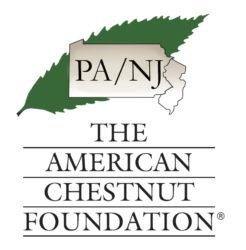Artificial inoculation: Trees are usually tested for blight resistance by taking the blight, putting it in the trees, and then seeing how the trees resist the infection. Those trees that don’t pass the test are rogued, i.e. they are removed from the orchard and, usually, burned. Those trees that look as though they have resistance are kept in the orchard and either control pollinated, or allowed to breed with each other.
Picture of Inoculum
Picture Inserting inoculum
More information on the steps of inoculation may be found at the PSU Growers site:
http://sfr.psu.edu/public/chestnut/breeding/inoculation
Natural inoculation: Depending on the type of trees planted and breeding scheme followed, some orchards are selected through infection by natural inoculum. In some cases, it may take several years for the tree to become infected by natural means but, in general, almost all trees in a concentrated orchard will become infected within 15 – 20 years. As above, those that exhibit resistance are kept and allowed to breed while the others are rogued.
Picture of blighted tree?
